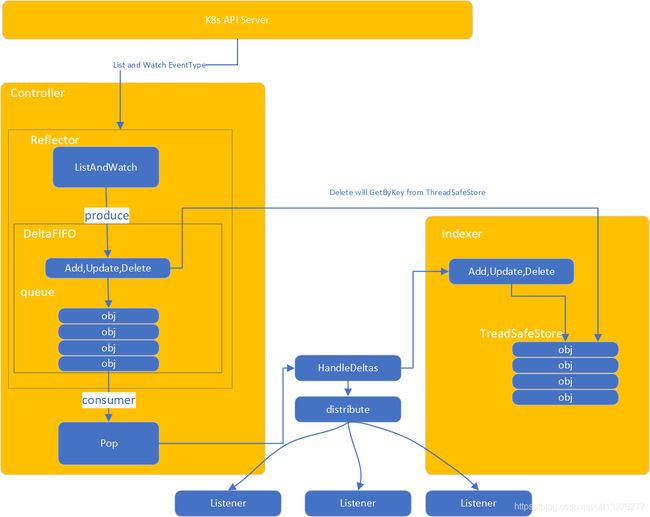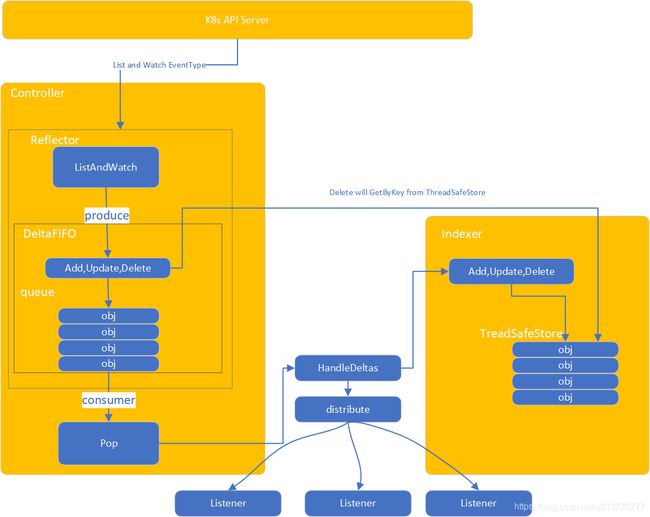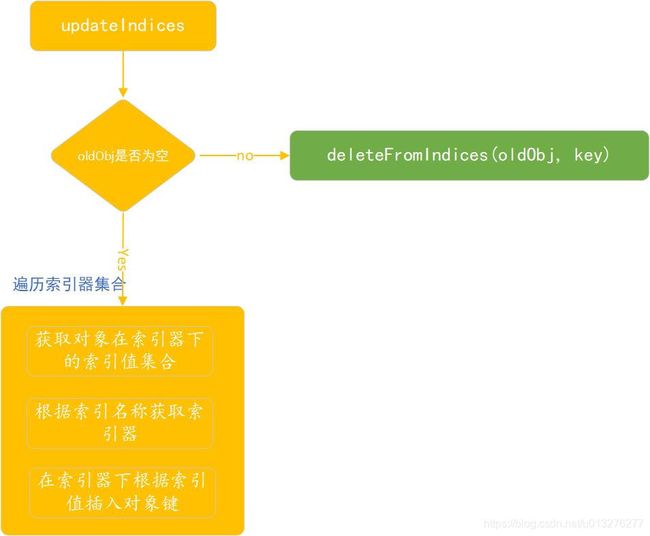Client-go之Informer机制本地存储Indexer
Client-go之Informer机制本地存储Indexer
背景
client-go Informer机制的主要逻辑是controller控制reflector从apiserver获取感兴趣的资源对象的数据,然后将数据放入DeltaFIFO队列中,controller将从队列中消费出对象增量数据,然后将增量存入本地存储,同时根据增量类型(Added,Update,Delete)进行事件通知。那么client-go中的本地存储是什么样的存在呢?我们之前常听说k8s中的list-watch机制能够让用户在取对象数据时直接在本地捞数据,而不是请求apiserver获取,从而减轻apiserver的压力,其中的本地数据就是本地存储Indexer中所存储的数据。所以本文就研读client-go的本地存储Indexer,探求其实现原理。

Indexer
在读Indexer部分代码时,有些概念有点搞不清,也不明白这样设计的原因,直到我看到了阳明大佬的文章(https://mp.weixin.qq.com/s/xCa6yZTk0X76IZhOx6IbHQ)。 大佬对于Indexer理解以及举例简直是妙啊,这边也推荐各位小伙伴看下阳明大佬的文章,加深理解。
本地存储Indexer涉及的源码文件有:
client-go\tools\cache\index.go
client-go\tools\cache\store.go
client-go\tools\cache\thread_safe_store.go
Indexer接口
本地存储接口定义为Indexer,中文可以意为索引器,那么为什么要叫索引器呢?比如,我们client-go中一般是根据namespace或者资源名称等来取对象,这个取对象的过程其实就是在本地存储取的。那把本地存储当成数据库,为了能更快的获取数据,你需要使用索引。同样这边的Indexer就是充当索引的功能,但是,就像你数据库中一张表可能不止一个索引吧,对于一个资源对象,你获取它的方式除了通过名称,还能通过命名空间,如果对象是pod,还能通过nodename来找出满足条件的对象,所以针对一类资源的索引器可以有多个的。了解了Indexer的用途,我们来看下索引器Indexer接口中的函数:
type Indexer interface {
Store // store接口
// 根据索引器名称和对象,获取存储的对象
Index(indexName string, obj interface{}) ([]interface{}, error)
// 根据索引器名称和被索引的值获取被存储对象的key
IndexKeys(indexName, indexedValue string) ([]string, error)
// 根据索引器名称获取该索引器被索引的值
ListIndexFuncValues(indexName string) []string
// 根据索引名称和被索引的值获取对象
ByIndex(indexName, indexedValue string) ([]interface{}, error)
// 获取索引器
GetIndexers() Indexers
// 添加新的索引器
AddIndexers(newIndexers Indexers) error
}
继续该文件中定义有关Indexer的类型:理解IndexFunc、Index、Indexers、Indice这几个结构,对于理解indexer至关重要,整个indexer就围绕这个几个结构进行操作了。
// 定义索引函数类型,根据一个对象可以计算一系列可被索引的值,一般被索引值只有一个,见下面的函数。
type IndexFunc func(obj interface{}) ([]string, error)
// 默认的indexFunc,根据Namespace定义的索引函数,返回数据为命名空间
func MetaNamespaceIndexFunc(obj interface{}) ([]string, error) {
meta, err := meta.Accessor(obj)
if err != nil {
return []string{""}, fmt.Errorf("object has no meta: %v", err)
}
return []string{meta.GetNamespace()}, nil // 索引值集就是Namespace
}
type Index map[string]sets.String // 索引值对应对象键集合,比如命名空间索引,命名空间名称对应命名空间下的对象键集合,根据对象键可以获取对象
type Indexers map[string]IndexFunc // 根据索引器名称获取索引函数,一个索引必须有自己的索引函数
type Indices map[string]Index // 索引器集合(相当于一张表有很多索引),根据索引器名称获取索引器
Indexer的实现cache
属性
type cache struct {
cacheStorage ThreadSafeStore // 安全存储,是个接口
keyFunc KeyFunc // 用于计算对象键
}
因为cache中很多方法都是调用了ThreadSafeStore中的方法,所以有必要先看下ThreadSafeStore接口及其实现类。
ThreadSafeStore接口及其实现
看下ThreadSafeStore接口:
type ThreadSafeStore interface {
Add(key string, obj interface{})
Update(key string, obj interface{})
Delete(key string)
Get(key string) (item interface{}, exists bool)
List() []interface{}
ListKeys() []string
Replace(map[string]interface{}, string)
Index(indexName string, obj interface{}) ([]interface{}, error)
IndexKeys(indexName, indexKey string) ([]string, error)
ListIndexFuncValues(name string) []string
ByIndex(indexName, indexKey string) ([]interface{}, error)
GetIndexers() Indexers
AddIndexers(newIndexers Indexers) error // 添加索引器
Resync() error // 方法被弃
}
继续看下ThreadSafeStore的实现threadSafeMap
属性:
type threadSafeMap struct {
lock sync.RWMutex // 一把读写锁
items map[string]interface{} // 一个Map。是用来存对象的,根据对象键可以在该Map中获取对象
indexers Indexers // map[string]IndexFunc ,索引名称->indexfunc
indices Indices // map[string]Index , 索引名称->索引器
}
初始化方法NewThreadSafeStore:
只需要传入Indexers和Indices两个map即可
func NewThreadSafeStore(indexers Indexers, indices Indices) ThreadSafeStore {
return &threadSafeMap{
items: map[string]interface{}{},
indexers: indexers,
indices: indices,
}
}
方法(增删改):
这几个方法在修改完items中的对象后,还需要对Indices操作,因为你操作对象后还需要修改下索引后面的对象键集合
func (c *threadSafeMap) Add(key string, obj interface{}) {
c.lock.Lock() // 加锁
defer c.lock.Unlock() //解锁
oldObject := c.items[key] // 获取该key下的老对象
c.items[key] = obj // 覆盖,key为对象键直接存入,index存储的key也需要添加。(获取对象时先去索引器获取对象键集合,然后再根据对象键到items中拿对象)
c.updateIndices(oldObject, obj, key) // 要是有老对象就先删除老对象,在更新新对象到index
}
func (c *threadSafeMap) Update(key string, obj interface{}) {
c.lock.Lock()
defer c.lock.Unlock()
oldObject := c.items[key]
c.items[key] = obj
c.updateIndices(oldObject, obj, key)
}
func (c *threadSafeMap) Delete(key string) {
c.lock.Lock()
defer c.lock.Unlock()
if obj, exists := c.items[key]; exists {
c.deleteFromIndices(obj, key) // 从Indice中删除老对象
delete(c.items, key)
}
}
updateIndices方法:
func (c *threadSafeMap) updateIndices(oldObj interface{}, newObj interface{}, key string) {
if oldObj != nil { // 老对象不为空,那就从Indice中删除老对象
c.deleteFromIndices(oldObj, key) // 将obj从每个管理的Index中删除
}
for name, indexFunc := range c.indexers { // 遍历索引器
indexValues, err := indexFunc(newObj) // 获取对象在这个索引下索引值集合。比若说,default命名空间下在Node1上的pod1,它的对应的索引有命名空间索引、Pod名称索引,nodename索引,pod在每个索引里的索引键集合是default,pod1,Node1
if err != nil {
panic(fmt.Errorf("unable to calculate an index entry for key %q on index %q: %v", key, name, err))
}
index := c.indices[name] // 根据索引名称获取索引器
if index == nil { // 索引器为空,该新对象之前没建过索引,这边给它新建一个
index = Index{}
c.indices[name] = index // 新建这个索引
}
// 索引不为空
// 将获取到的索引键集合中索引值对应的对象数据添加上
for _, indexValue := range indexValues { // 遍历索引键集合
set := index[indexValue] // 在索引器中获取索引值集合
if set == nil { // 对象键集合为空
set = sets.String{}
index[indexValue] = set // 集合为空,就新建一个
}
set.Insert(key) // 将新的对象键添加进去
}
}
}
Get方法:
根据对象键获取对象
func (c *threadSafeMap) Get(key string) (item interface{}, exists bool) {
c.lock.RLock()
defer c.lock.RUnlock()
item, exists = c.items[key] // 从item中根据对象键拿对象
return item, exists
}
List():
返回本地存储中资源对象的一份拷贝
func (c *threadSafeMap) List() []interface{} {
c.lock.RLock()
defer c.lock.RUnlock()
list := make([]interface{}, 0, len(c.items))
for _, item := range c.items {
list = append(list, item)
}
return list // 返回item中所有的对象
}
ListKey:
获取所有的对象键
func (c *threadSafeMap) ListKeys() []string {
c.lock.RLock()
defer c.lock.RUnlock()
list := make([]string, 0, len(c.items))
for key := range c.items {
list = append(list, key)
}
return list
}
ListKeys:
获取所有对象键
func (c *threadSafeMap) ListKeys() []string {
c.lock.RLock()
defer c.lock.RUnlock()
list := make([]string, 0, len(c.items))
for key := range c.items {
list = append(list, key)
}
return list
}
Replace:
func (c *threadSafeMap) Replace(items map[string]interface{}, resourceVersion string) {
c.lock.Lock()
defer c.lock.Unlock()
c.items = items // map替换
// 重新构建所有的索引
c.indices = Indices{} // indice清空
for key, item := range c.items {
c.updateIndices(nil, item, key)// 构建新的索引器
}
}
Index:
根据索引名称和查询对象,获取一组该索引下的对象键集合
func (c *threadSafeMap) Index(indexName string, obj interface{}) ([]interface{}, error) {
c.lock.RLock()
defer c.lock.RUnlock()
indexFunc := c.indexers[indexName] // 获取索引器即索引函数
if indexFunc == nil {// 索引器的索引函数不能为空,否则会出错
return nil, fmt.Errorf("Index with name %s does not exist", indexName)
}
indexedValues, err := indexFunc(obj) // 获取对象在该索引下的值集合
if err != nil {
return nil, err
}
index := c.indices[indexName] //获取索引器
var storeKeySet sets.String
if len(indexedValues) == 1 { // 只有一个Index
// 大多数情况下,这里只有一个值,
storeKeySet = index[indexedValues[0]] // 获取索引里的对象键集合
} else {
// 去重
storeKeySet = sets.String{}
for _, indexedValue := range indexedValues {
for key := range index[indexedValue] {
storeKeySet.Insert(key)
}
}
}
// 返回对象键集合的拷贝
list := make([]interface{}, 0, storeKeySet.Len())
for storeKey := range storeKeySet {
list = append(list, c.items[storeKey])
}
return list, nil
}
ByIndex:
根据索引名称和被索引的值,获取对象键集合,是一份拷贝
// ByIndex returns a list of the items whose indexed values in the given index include the given indexed value
func (c *threadSafeMap) ByIndex(indexName, indexedValue string) ([]interface{}, error) {
c.lock.RLock()
defer c.lock.RUnlock()
indexFunc := c.indexers[indexName] // 获取索引函数
if indexFunc == nil { // 这边的判空也是对索引合法性的检查,如果都不存在索引函数,那就没必要继续了
return nil, fmt.Errorf("Index with name %s does not exist", indexName)
}
index := c.indices[indexName] // 根据索引器名字查找索引器
set := index[indexedValue] // 根据被索引的值获取索引的对象key集合
list := make([]interface{}, 0, set.Len()) // 构造一个拷贝返回出去
for key := range set {
list = append(list, c.items[key])
}
return list, nil
}
IndexKeys:
根据索引名称和索引值获取对象键集合
func (c *threadSafeMap) IndexKeys(indexName, indexedValue string) ([]string, error) {
c.lock.RLock()
defer c.lock.RUnlock()
// indexFunc用于判断索引是否存在
indexFunc := c.indexers[indexName] // 获取索引函数
if indexFunc == nil {
return nil, fmt.Errorf("Index with name %s does not exist", indexName)
}
index := c.indices[indexName] // 获取索引
set := index[indexedValue] // 获取对象键集合
return set.List(), nil
}
ListIndexFuncValues:
根据索引器名称获取该索引下的所有对象键集合
func (c *threadSafeMap) ListIndexFuncValues(indexName string) []string {
c.lock.RLock()
defer c.lock.RUnlock()
index := c.indices[indexName] // 获取索引器
names := make([]string, 0, len(index))
for key := range index {
names = append(names, key)
}
return names// 返回改索引下的所有Key的集合
}
AddIndexers:
添加索引器
func (c *threadSafeMap) AddIndexers(newIndexers Indexers) error {
c.lock.Lock()
defer c.lock.Unlock()
if len(c.items) > 0 { // 已经有对象数据了,就不能添加索引器了
return fmt.Errorf("cannot add indexers to running index")
}
oldKeys := sets.StringKeySet(c.indexers) // 老的索引器名称集合
newKeys := sets.StringKeySet(newIndexers) // 新的索引器名称集合
if oldKeys.HasAny(newKeys.List()...) { // 新老索引集合索引名称有重合就不允许了
return fmt.Errorf("indexer conflict: %v", oldKeys.Intersection(newKeys))
}
// 添加新的索引器
for k, v := range newIndexers {
c.indexers[k] = v
}
return nil
}
deleteFromIndices:
从indice中指定的Index下删除对象键
func (c *threadSafeMap) deleteFromIndices(obj interface{}, key string) {
for name, indexFunc := range c.indexers { // 遍历索引器几个
indexValues, err := indexFunc(obj) // 获取对象索引值集合
if err != nil {
panic(fmt.Errorf("unable to calculate an index entry for key %q on index %q: %v", key, name, err))
}
index := c.indices[name] // 根据索引器名字获取索引器
if index == nil { //找不到index
continue
}
// 找到对应的索引器了
for _, indexValue := range indexValues { // 遍历对象的索引值数组
set := index[indexValue] // 获取对象键结合
if set != nil { // 对象键集合不为空
set.Delete(key) // 从对象键集合中删除待删除对象的key
if len(set) == 0 { // 如果删除后,对象键集合为空,就删除该索引
delete(index, indexValue)
}
}
}
}
}
cache的方法
1、增删改方法:
看完threadSafeMap再来看这个,你会发现这边的增删改方法就是调用了threadSafeMap中的增删改方法。
func (c *cache) Add(obj interface{}) error {
key, err := c.keyFunc(obj)
if err != nil {
return KeyError{obj, err}
}
c.cacheStorage.Add(key, obj)
return nil
}
// Update sets an item in the cache to its updated state.
func (c *cache) Update(obj interface{}) error {
key, err := c.keyFunc(obj)
if err != nil {
return KeyError{obj, err}
}
c.cacheStorage.Update(key, obj)
return nil
}
// Delete removes an item from the cache.
func (c *cache) Delete(obj interface{}) error {
key, err := c.keyFunc(obj)
if err != nil {
return KeyError{obj, err}
}
c.cacheStorage.Delete(key)
return nil
}
2、其他方法
同样都是对threadSafeMap的一层封装
func (c *cache) List() []interface{} {
return c.cacheStorage.List()
}
// ListKeys returns a list of all the keys of the objects currently
// in the cache.
func (c *cache) ListKeys() []string {
return c.cacheStorage.ListKeys()
}
// GetIndexers returns the indexers of cache
func (c *cache) GetIndexers() Indexers {
return c.cacheStorage.GetIndexers()
}
// Index returns a list of items that match on the index function
// Index is thread-safe so long as you treat all items as immutable
func (c *cache) Index(indexName string, obj interface{}) ([]interface{}, error) {
return c.cacheStorage.Index(indexName, obj)
}
func (c *cache) IndexKeys(indexName, indexKey string) ([]string, error) {
return c.cacheStorage.IndexKeys(indexName, indexKey)
}
// ListIndexFuncValues returns the list of generated values of an Index func
func (c *cache) ListIndexFuncValues(indexName string) []string {
return c.cacheStorage.ListIndexFuncValues(indexName)
}
func (c *cache) ByIndex(indexName, indexKey string) ([]interface{}, error) {
return c.cacheStorage.ByIndex(indexName, indexKey)
}
func (c *cache) AddIndexers(newIndexers Indexers) error {
return c.cacheStorage.AddIndexers(newIndexers)
}
// Get returns the requested item, or sets exists=false.
// Get is completely threadsafe as long as you treat all items as immutable.
func (c *cache) Get(obj interface{}) (item interface{}, exists bool, err error) {
key, err := c.keyFunc(obj)
if err != nil {
return nil, false, KeyError{obj, err}
}
return c.GetByKey(key)
}
// GetByKey returns the request item, or exists=false.
// GetByKey is completely threadsafe as long as you treat all items as immutable.
func (c *cache) GetByKey(key string) (item interface{}, exists bool, err error) {
item, exists = c.cacheStorage.Get(key)
return item, exists, nil
}
// Replace will delete the contents of 'c', using instead the given list.
// 'c' takes ownership of the list, you should not reference the list again
// after calling this function.
func (c *cache) Replace(list []interface{}, resourceVersion string) error {
items := make(map[string]interface{}, len(list))
for _, item := range list {
key, err := c.keyFunc(item)
if err != nil {
return KeyError{item, err}
}
items[key] = item
}
c.cacheStorage.Replace(items, resourceVersion)
return nil
}
// Resync is meaningless for one of these
func (c *cache) Resync() error {
return nil
}
cache初始化
初始化的时候只传入了一个KeyFunc用于获取对象Key,然后在里面新建了ThreadSafeStore对象。并初始化了Indexer和Indices。
func NewStore(keyFunc KeyFunc) Store {
return &cache{
cacheStorage: NewThreadSafeStore(Indexers{}, Indices{}),
keyFunc: keyFunc,
}
}
不知道读者是否好奇传进来的KeyFunc是什么样的?我在controller.go中找到了使用NewStore的调用者:
func NewInformer(
lw ListerWatcher,
objType runtime.Object,
resyncPeriod time.Duration,
h ResourceEventHandler,
) (Store, Controller) {
clientState := NewStore(DeletionHandlingMetaNamespaceKeyFunc) // 新建Indexer,传入DeletionHandlingMetaNamespaceKeyFunc作为keyfunc
return clientState, newInformer(lw, objType, resyncPeriod, h, clientState)
}
DeletionHandlingMetaNamespaceKeyFunc函数:
func DeletionHandlingMetaNamespaceKeyFunc(obj interface{}) (string, error) {
if d, ok := obj.(DeletedFinalStateUnknown); ok { // DeletedFinalStateUnknown表示因为与apiserver失联导致的对象本地存在,而api-server已经删除的意外状态
return d.Key, nil
}
return MetaNamespaceKeyFunc(obj) // 正常使用的keyFunc是这个
}
MetaNamespaceKeyFunc函数:
func MetaNamespaceKeyFunc(obj interface{}) (string, error) {
if key, ok := obj.(ExplicitKey); ok { // 对象是个字符串,就返回字符串
return string(key), nil
}
meta, err := meta.Accessor(obj) // 获取对象的Meta数据
if err != nil {
return "", fmt.Errorf("object has no meta: %v", err)
}
if len(meta.GetNamespace()) > 0 { // 如果对象存在命名空间,那就返回namespaxce/name的形式作为对象键。(像node这样的资源,是不存在namespace设置的,一般为空)
return meta.GetNamespace() + "/" + meta.GetName(), nil
}
return meta.GetName(), nil // 没有namespace的对象,就返回name作为对象键
}
基于以上初始化过程以及调用,我们了解到,新建Indexer是只需要传入KeyFunc,然后内部初始化ThreadSafeStore。对于KeyFunc到底是什么样的,我们也探究过了,对象键取决于对象,分为三种返回:
- 对象是string,那就返回string
- 对象有Meta数据,对象Namespace不为空,对象键为:namespaxce/name
- 对象有Meta数据,对象Namespace为空, 对象键为:name
总结
本篇文章主要介绍了client-go种的Indexer源码,Indexer充当的是内部存储的角色,用途是在本地缓存一份用户感兴趣的数据,用户取对象数据一般不直接访问apiserver,先去缓存取数据,这样就减轻了apiserver和etcd集群的压力。Indexer作为内存存储的同时,还实现了针对资源对象的索引机制,且可以自己定义索引器,使得本地存储获取资源比较快,这边的索引简单理解就是个Map,Map的特性就是便于查询。


